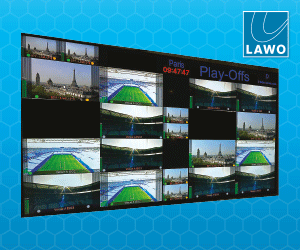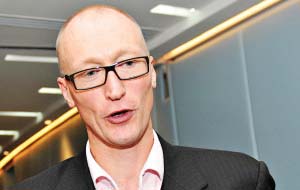Viewers change behaviours at times confounding analysts with figures that go awry. A minute-by-minute analysis, however, reveals the most rewarding slots for advertisers, who need to choose smartly and keep the viewers engaged during ad breaks The voting is in and the winner can be announced Arab Idol is the most popular programme of […]
 Viewers change behaviours at times confounding analysts with figures that go awry. A minute-by-minute analysis, however, reveals the most rewarding slots for advertisers, who need to choose smartly and keep the viewers engaged during ad breaks
Viewers change behaviours at times confounding analysts with figures that go awry. A minute-by-minute analysis, however, reveals the most rewarding slots for advertisers, who need to choose smartly and keep the viewers engaged during ad breaks
The voting is in and the winner can be announced Arab Idol is the most popular programme of the year.
Im writing this in July, during Ramadan, but Im very confident there will be no serious challengers to this in the second half of the year, or among the big Ramadan programmes.
The UAE victory in the Gulf Cup ran it close but Arab Idol is the winner with a shade under 320,000 viewers on MBC1 at its peak minute, just as Mohamed Assaf was being announced as the winner. In fact, there were another 91,000 viewers at that time on MBC Masr and Al Hayat as it was shown simultaneously, giving a combined viewing of 411,000 and around two in every three Arab-speaking viewers at the time.
But the gross figures are just one obvious dimension as there is much to learn looking at the details of the viewing on a minute-by-minute level. The beauty of a programme like this, from a research point of view is that with a large sample and audience it shows trends much more clearly. (The figures here comprise Emiratis and Arabs).
Reality is the Reality
The first point is that while reality might be falling away in other parts of the world, it is very much alive in the Arab market. The 411,000 gross figure was up 21,000 over 2012, an increase of 5%.
By contrast, in the US, American Idol has been dropping year on year. The final episode this year attracted 14.3 million viewers, which sounds like a lot until you realise it was a 33% drop over the 2012 figures, and those were the previous
low point.
Admittedly, they were in Season 12 and we were in Season 2, but it does show that all good things come to an end. A few years ago the Million Poets programme was lauded as the biggest thing on the box
but such formats are barely on the radar.
Predicting the Future
An interesting thing about the minute-to-minute ratings is how they predict the outcome. The Arab Idol format featured the final three contestants performing on Friday night ahead of the audience voting and the winner being announced on Saturday.
But anyone looking at the viewing figures could have made a shrewd bet that Mohamed Assaf would be the one to take the prize. These are the viewing peaks when each of the three finalists was performing. (See Table 1, below)
The Mohamed Yousef minute was also the highest for the Friday night programme, overall, despite the fact that such shows tend to build audience over their duration, and he was the earliest to perform.
Many people have a static view of audiences. I have conversations with programmers and schedulers who think when a show changes its figures either during transmission or from day to day, it is a sign that there is something wrong with the figures, not the programme. The fact is that people change their behaviour in ways that confound our best efforts to put them into neat rows.
I can imagine that when Mohamed Assaf started to perform, perhaps one person in a household was viewing and then called others in to watch. Or perhaps the fact that he was on first meant that a number of his fans, having seen their favourite, decided not to view the others and changed channels, perhaps returning at the voting stage. These are normal behaviours. If anything, the odd behaviour is to sit and watch an entire programme.
Table 2 shows the number of minutes consumed by the Arab Idol audience in ten-minute blocks. To the left are the people who viewed less than 10 minutes and to the right are the ones who viewed the whole programme.
As you can see, just over 20% of the viewers watched the whole show and about 54% watched two hours or more, while more than 30% watched less than an hour. I can tell you that this is a highly unusual pattern for most programmes, the vast majority of viewing is for smaller periods of consumption.
Advertising
Idols
Anyway, enough about singers the real contestants are the advertisers, so how did they do? Again, minute-by-minute analysis provides a picture that we cant get elsewhere. (See Table 3)
Table 3 shows the pattern of three ad breaks during the Saturday night programme by minute and rating in thousands. The first three and last three minutes are the actual programme time.
Now, if you buy your advertising by programme, you pay a set fee regardless of how the spot performs. As we can see, however, the break your ad was shown in and the position it was shown in, will have a huge impact on the numbers who viewed it.
The overall programme average was more than 260,000 but those who were in the lowest advertising minute at 22:51 had 160,000 viewers.
The winners in this are the quick promo stings at the top of the breaks in this case, sponsors and advertisers such as Pepsi, Kit Kat, Chevrolet and Maybelline. Being at the end of the break also helps, as viewers come back to see if the programme has re-started Samsung benefited from this effect.
Its something presenters and producers need to be aware of. At one moment when the words “after the break” were heard, there was a drop of 19,000 viewers in a matter of seconds.
The challenge then is to keep viewers entertained and engaged during ad breaks. This is potentially where social media and other devices come into play. Luring viewers into tweeting, commenting and so on, during ad breaks or even about advertising spots helps. The agency that can deliver this service for a client will surely be singing the right tune.










































































